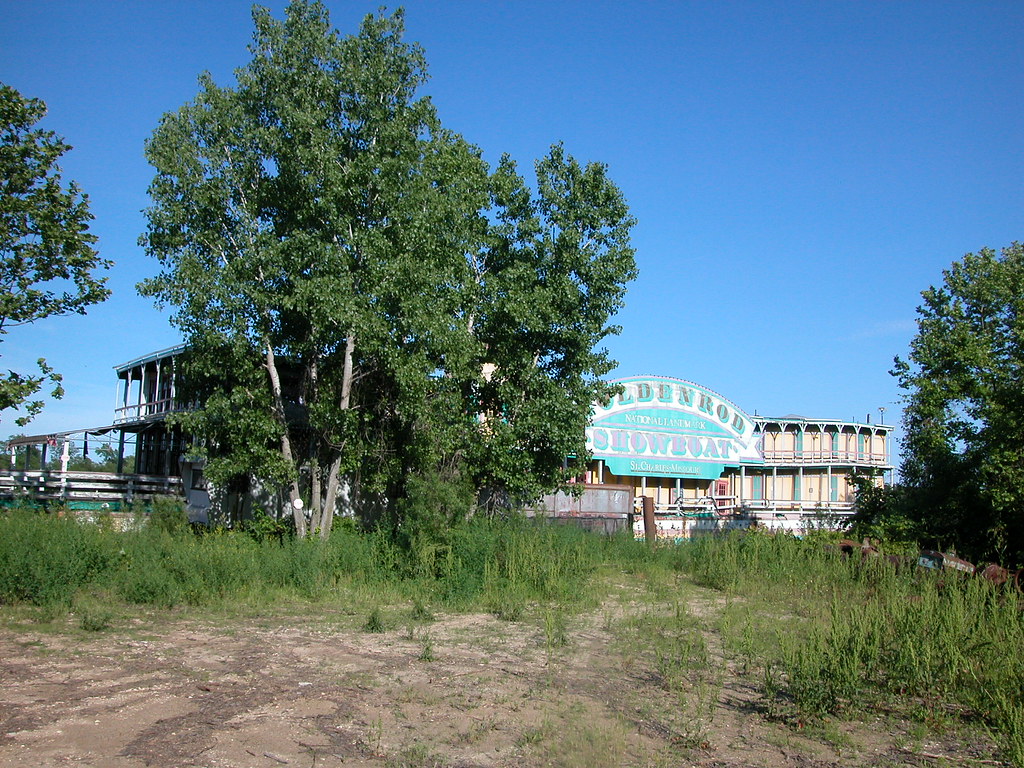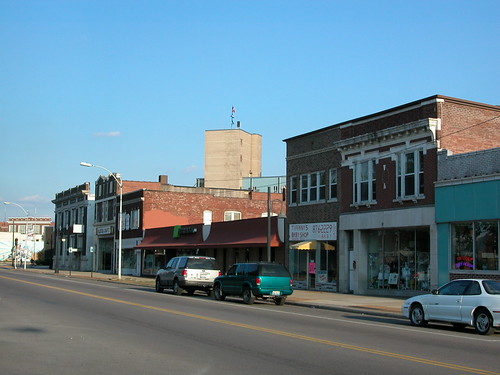by Michael R. Allen
 The day was beautiful, and our need for a trip away from the city strong. Looking for a destination, we settled on tracking down the Goldenrod Showboat on the Illinois River. After all, we are in the venerable entertainment vessel’s 100th year. Using directions from a friend sent last year after he stumbled upon it and Google Earth (which showed it a few miles from where it actually lies), we got a general idea of the location in Kampsville, Illinois and set out.
The day was beautiful, and our need for a trip away from the city strong. Looking for a destination, we settled on tracking down the Goldenrod Showboat on the Illinois River. After all, we are in the venerable entertainment vessel’s 100th year. Using directions from a friend sent last year after he stumbled upon it and Google Earth (which showed it a few miles from where it actually lies), we got a general idea of the location in Kampsville, Illinois and set out.
Of course, the Goldenrod now sits outside of its first Kampsville location. After not finding the boat on the town’s riverfront, we asked a couple walking down the road how to find it. The man knew where it was, gave directions and proceeded to offer the information that his aunt was a waitress and actress on the Goldenrod between 1945 and 1950. Even in this unlikely new home, the Goldenrod is part of a local’s family heritage — how ’bout that?
A few miles later, we spotted the Goldenrod moored to a barge on a section of overgrown riverfront. The boat was unmistakable, and the deterioration has not claimed much of its integrity. Everything is still there, down to the boat’s recent (and somewhat unattractive) paint scheme. The paint is peeling, the wood drying and in some places rotting. Yet the Goldenrod survives unharmed in its sleepy Illinois berth.
A few years ago, this outcome was far from likely. After its itinerant early years (more on those later), the show boat became a permanently-moored restaurant on the St. Louis riverfront. In 1990, the City of St. Charles, which had purchased the boat in 1988, moved it to the St. Charles riverfront. The restaurant closed in 2001, and in 2003 the city decided to sell the boat. The St. Charles City Council accpeted bids, and sold it to a company headed by John Schwarz. (The Council rejected Bob Cassilly’s bid to move it back to the St. Louis riverfront.) Schwarz moved the boat to Kampsville, after announcing plans to restore the vintage vessel.

However, in 2007, Randy Newingham and Shelia Prokuski, owners of the site where the boat was moored, sued Schwarz for unpaid mooring fees. In September 2007, Newingham threatened to sell all or part of the boat for scrap to cover his costs. One month later, a Calhoun County judge ordered an auction of the boat, and the court accepted Newingham and Prokuski’s lone $50,000 bid. However, by the end of the year the couple had reached and agreement to sell the Goldenrod back to John Schwarz. Schwarz moved the boat north. In 2008, however, Judge Richard Greenleaf declared that the proper court papers for the auction had not been filed, throwing the ownership in doubt. To date, the ownership has not been cleared.
Hence, the Goldenrod Showboat sits lonely on the side of Illinois Highway 100, and as summer sets in, disappears behind stands of grasses and the leaves of riverbank trees. The sturdy boat is crumbling, but not very rapidly. Asphalt roof paper provides cover for much of the deck area, and the boat is locked up tight. Hopefully, this is not how the Goldenrod will end its days, even if this sad state is how the boat will spend its centennial year.

The path from birth has been convoluted, but most of the Goldenrod’s days have been good ones. Pope Dock Company of Parkersburg, West Virginia built the boat in 1909 for businessman W.R. Markle. Originally, the boat was named Markle’s New Showboat. Built for entertainment, the boat would travel the Mississippi and Ohio rivers and stop at town where it would dock. Patrons would come aboard for a night of music, comedy and other live entertainment. According to most accounts, the boat was the last showboat built for the Mississippi and Ohio river circuits. At 200 feet long and 43 feet wide, the boat was one of the largest showboats ever built. The seating capacity was 1,400.
Markle lost the boat through foreclosure in 1913, and the next owner renamed the vessel the Goldenrod Showboat. In 1922, Captain Bill Menke purchased the boat and implemented a 12-month touring schedule. His tenure would be long and fruitful. Menke moored the boat at Aspinwall, Pennsylvania for two consecutive summers, 1930 and 1931. In summer 1937, Menke brought his show palace to St. Louis for repairs but ended up permanently mooring it here. According to “That Landmark on the River,” an article by Mary Duffe that appeared in the St. Louis Post-Dispatch on December 10, 1968, the boat hosted stars like Red Skelton, Monte Blue, Kathy Nolan, Major Bowes and others during Menke’s tenure. Menke reported that he had to ask patrons in southern towns to leave their firearms at the riverbank.
In 1963, Pierson and Franz purchased the Goldenrod Showboat. A few small fires led to major renovation, including a new steel hull. On Christmas Eve 1967, the National Park Service listed the Goldenrod Showboat as a National Historic Landmark, the highest federal distinction for a historic property. The National Historic Landmark nomination includes a short history of the boat, as well as the fact that the original hull is intact inside of the steel barge that now serves as the hull.
The National Historic Landmark nomination may be skimpy by today’s standards of historic documentation, but the nomination’s assertion of the great cultural significance of the Goldenrod remains true. This was one of the last and most lavish of the great river show boats, and it may be the only survivor of that type. Its future is important not only to St. Louis, its later home, but to the history of the 15 states the Goldenrod is known to have regularly visited between 1909 and 1937. The centennial of the boat should be a spur toward preservation. If the current owners (whoever they may be legally) cannot figure out how to bring the boat back to life, let’s find the person who can.
 Last year, the building at 1310 Niedringhaus Avenue in downtown Granite City burned. The neighbor at 1308 Niedringhaus (at right above) suffered some damage, but nothing that compromised its structural integrity.
Last year, the building at 1310 Niedringhaus Avenue in downtown Granite City burned. The neighbor at 1308 Niedringhaus (at right above) suffered some damage, but nothing that compromised its structural integrity. One can see that these buildings were part of an uninterrupted row of downtown buildings with storefront retail activity. Such blocks are few and far between in Granite City these days. Now there is one less, because the government of Granite City successfully pushed to have both the buildings at 1308 and 1310 Niedringhaus Avenue demolished. Today, the site is a gaping hole in the street wall.
One can see that these buildings were part of an uninterrupted row of downtown buildings with storefront retail activity. Such blocks are few and far between in Granite City these days. Now there is one less, because the government of Granite City successfully pushed to have both the buildings at 1308 and 1310 Niedringhaus Avenue demolished. Today, the site is a gaping hole in the street wall. 






